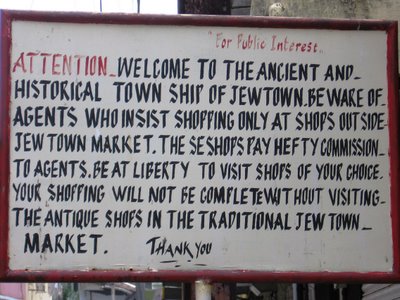Fort Cochin: The Bizarre and Bazaars
Fort Cochin is my favorite place in India thus far -- perhaps that's because it was exactly what I needed when I got there. With tropical weather, a mix of Dutch architecture and bright Indian colors, and winding streets filled with quaint restaurants and cafes, I was in heaven relaxing and sipping coffee and wine over succulent seafood meals.
I stayed at Kimansion, which I highly recommend. For about $22 per night you get a big room and nice bathroom in a converted Dutch mansion, and it comes with breakfast. You're also within walking distance of all the major sites. I really loved it:

There are also some nice boutique hotels, like Koder House and Malabar House -- but they are 10X as expensive as the other converted Dutch homes, and you can dine in their posh outdoor courtyards anyway (which is what I did). You're better off paying less for your room and splurging on other things. If you want a balance of luxury and price, Rossitta Wood Castle looked nice, although still on the pricier side. (I ate there, too, and the food was good).
Go to Kashi Art Cafe when you want to unwind and link up with fellow travelers. They serve breakfast every day, usually some kind of eggs with homeade bread, and great coffee.
Cochin is famous for its seafood, and one of the major sites are the Chinese fishing nets located in the center of town. It takes 3 men to operate each net:

You can visit the fishmongers in the center of town and purchase fresh fish, which many of the restaurants will cook up for you on the spot. This guy tried to sell me a gigantic grouper, which was a bit more than I can eat even at my hungriest:

One of the highlights of my trip was taking an auto rickshaw tour with Sayin, a local driver and tour guide. He took me to some really interesting places I never would have found on my own, and brought me for a traditional Indian thali lunch. If you're going to Fort Cochin, email me and I'll send you his contact info.
Our first stop was an Indian laundry facility where every garment is whipped against concrete and then pressed with a hot coal iron. I bet this is what happens to my laundry, although I'll probably never really know:


Then, we went to a 'pickle' factory housed in a beautiful Dutch building. You can see Sayin waiting for me at the end:

The pickles are not what we think of, though. They are more what we would call 'chutney'. I bought some of the mango and lemon, which were spicy and yummy. I bet Matt can make a mean marinade with them if I can smuggle them past the ultra-strict Indian airport security guards (liquids in your bag are a no-no, but you can carry large bottles of water right on through without anyone saying a word). Here are women making the pickle:

I know I'm starting to sound like a Sesame Street character, but do you ever wonder where fresh ginger comes from? Here are shots from a ginger factory. This is how they sift the pieces into large and small chunks/sprigs/whatever you call ginger:

Here's how they dry the ginger in the sun:

A lot of the ginger makes its way to the nearby Ayurvedic market. 'Ayurvedic' products and treatments are big here. They are all natural remedies to medical/health problems, and require many natural ingredients:

Sidenote: From my own rather traumatizing experience, an Ayurvedic massage means being rubbed vigorously with lots and lots of oil ALL OVER your body, sometimes by multiple people. Know what you're getting into before signing up for one -- it is not the relaxing, modest 'massage' experience you probably imagine if you're from a Western culture. But it makes for a good story.
Next, we went to a rice storage facility. It sort of reminded me of the place where I left my car back in San Francisco, except there was no asbestos in the air as far as I could tell:


Cochin also has an interesting and mixed religious culture. Of course there are many Hindus and Muslims as in other parts of India. But there are also several other groups coexisting peacefully within the small area of Fort Cochin.
Jewtown still houses a small Jewish community who operate the area's bazaars and antique stores along winding, romantic streets. There is also an active synagogue at the end of the main alley:

You can almost imagine you've taken a step back in time to the days of tea and spice trade:



There are several Dutch and Portuguese churches dotting the streets as well -- some large cathedrals, and others tiny chapels. Kerala still has a large Christian population stemming from its days as a world trading hub:


Additionally, there is a fairly active Jain population. I knew nothing about Jainism when I arrived, but it seems to focus on spiritual indepedence, non-violence, and equality. There were 3 large buildings on the premises, each with different alters to worship. I happened to be there during a ceremony being performed by a Jain holy man (don't worry, they encouraged photography):


The best part of Cochin is the elegance of the place. I was constantly struck by the beautiful architecture and people. Everywhere you turn there's something exotic that gracefully mixes past and present:





Labels: Ayurvedic, Cochin, Fort Cochin, Fort Kochi




1 Comments:
Yeah boyeeeee! Jewtown REPRESENT!
5:25 PM
Post a Comment
<< Home